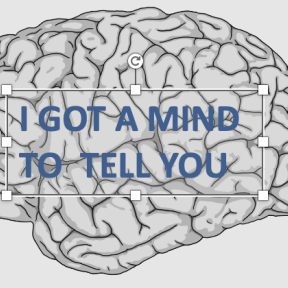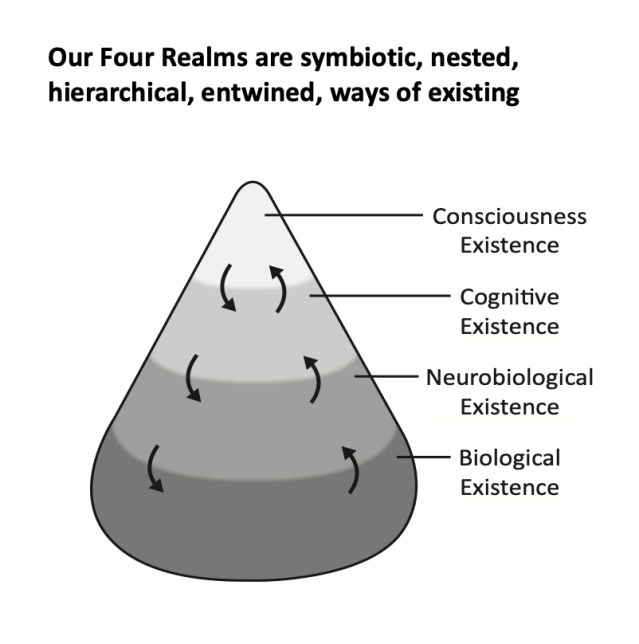CONSCIOUSNESS- Our Four Realms of Existence. Rethinking what and who we are.

KEY POINTS-
- All of life, including human conscious mental life, is physical.
- Our physical existence can be accounted for in terms of four entwined realms of existence.
- The four realms are biological, neurobiological, cognitive and conscious.

This post is Part 1 of a series about my new book, "The Four Realms of Existence"
Many of us understand that the mental aspect of who we are is embedded in the part of the body known as the brain, and therefore is also part of our physical, bodily existence. Still, even true believers of the physical nature of the mind sometimes feel as though it possesses some quality or qualities lacking in other physical systems within our body, and even within our brain.
We have firsthand knowledge of the mental states we refer to as perceptions, memories, thoughts, and emotions, but lack awareness of processes in the brain that control digestion, respiration, heart rhythm, and much of our behavior. What is it about the mental stuff that makes it seem different from the rest of the physical stuff that constitutes who and what we are?
Just as your mind depends on your brain, your brain, being part of your body, depends on the life-sustaining functions of other components of your body. If your heart stops beating, or your lungs collapse, all your other organs, including your brain, will soon cease to function in a way that is compatible with life. Without bodily life, there is no brain function, and without brain function, no mind.
How, then, out of all this biological physicality, do we each come to exist as a being that knows it was born in the past, knows that it exists now, and knows that it will someday die?
Self and Personality Are Not the Answer
The standard approach to such questions about individuality is to focus on psychological notions like the self or personality. These have long guided philosophical musings, as well as scientific theories and research, about what it is to be a human being. But there is little agreement about what self and personality refer to, and even whether they refer to real entities, as opposed to just being shorthand labels for a variety of psychologically interesting phenomena.
Here's what scholars from the past and present have had to say about the self:
- David Hume (philosopher): The elusive "I."
- Shaun Gallagher (philosopher): Despite the comfort level of the field to talk about the "the self," what is said is usually controversial.
- Daniel Dennett (philosopher): The "self" is an illusion.
- Thomas Metzinger (philosopher): Nobody ever had or was a "self."
- Owen Flanagan (philosopher): Just because "self" is in our vocabulary does not mean that it has any explanatory role.
- Joseph LeDoux: Your Self is not a thing. It is a story you create about who you are.
Similar issues have been raised about personality:
- Harry Stack Sullivan (personality psychologist): Personality is an illusion.
- Walter Michel (personality psychologist): Personality is a myth.
Scientific discoveries over the last several decades from diverse fields, such as neuroscience, genetics, and artificial intelligence, have led to new ideas about how human beings exist as physical systems. These findings, in challenging cherished assumptions about human nature, have resulted in an epistemological vacuum. In no small part, this is because thinking about “who and what we are” has not advanced significantly beyond traditional ideas, some put forth in ancient times.
The various phenomena that have been discovered while studying self and personality have, without question, provided important insights into human nature. But what if it is our scientific understanding of who and what we are that is confused? Specifically, what if our constructs are inadequate as conceptual hooks on which to hang the empirical findings that have been discovered in their name? Because these centuries-old notions obscure as much as they reveal, the phenomena might be better served by a new conceptual home, one grounded in contemporary scientific conceptions and empirical research.

Our Realms of Existence
A human being can be characterized as a composite of four fundamental, parallel, entwined realms of existence that reflect our evolutionary past and account for our present ways of being. These are: biological, neurobiological, cognitive, and conscious. All four are, deep down, biological. But the neurobiological realm transcends the mere biological, the cognitive transcends the mere neurobiological, and the conscious transcends the mere cognitive.
The four realms coalesce as an "ensemble of being." Together, the four realms, and the resulting ensemble, account for what and who we are, including those aspects of us that fall under the rubrics of the self and personality.
The four realms framework is not an exercise in reductionism, where higher psychological ways of being are explained in neurobiological terms, neurobiological ways in terms of biological, and biological in terms of chemistry and physics. It is, instead, about how symbiotic interactions between the levels sustain the overall existence of the human organism.

Each realm anatomically permeates and physiologically enables the level above it, and at the same time, the survival potential of the level below is enhanced by the one above. The realms somewhat resemble components of a Russian doll. But unlike a Russian doll, in which the parts simply stack on top of one another, our component realms are conjoined, integrated, and interdependent. Everything about an individual human being, biologically and psychologically (including all of what falls under "self" and "personality"), is subsumed within the entwined, nested, hierarchical, organization of our realms of existence.
It’s relatively easy to separate biological beings from non-living matter. If something is alive, it is a biological being. Deciding which biological beings exist neurobiologically is also relatively straightforward. If an organism has a nervous system, it is a neurobiological being and, by definition, it exists neurobiologically. That narrows things down to animals, or at least most animals.
When it comes to the cognitive and conscious realms, things are considerably more complex since there are no equivalent physical properties that unequivocally identify which organisms are cognitive and conscious beings. As a result, we have to rely on behavioral criteria. That can be tricky since different scientists define cognition and consciousness differently.
However, my primary goal is not to offer an account that animals are cognitive and or conscious. There are a lot of ideas, and controversy, about that floating around. Instead, what I have tried to do is to account how our four realms interact, and in so doing, make us human beings what and who we are.
In the next several posts I will unpack the biological, neurobiological, cognitive, and conscious realms of human existence.
- Questions and Answers
- Opinion
- Story/Motivational/Inspiring
- Technology
- Art
- Causes
- Crafts
- Dance
- Drinks
- Film/Movie
- Fitness
- Food
- Games
- Gardening
- Health
- Home
- Literature
- Music
- Networking
- Other
- Party
- Religion
- Shopping
- Sports
- Theater
- Wellness
- News
- Culture
- War machines and policy

